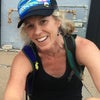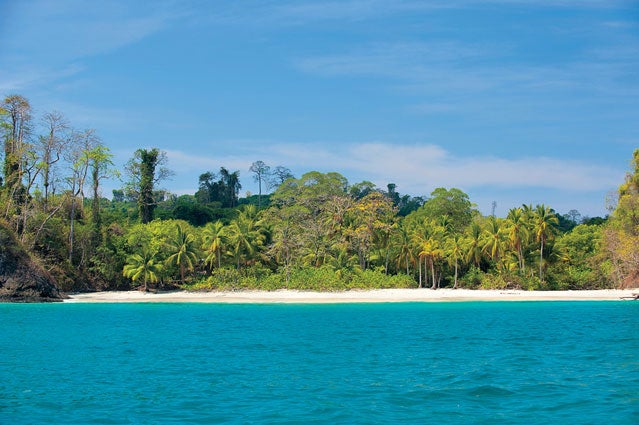Journey to the Center of the Earth
Dreading winter’s chill? It’s always summer in Central America, where you can still surf untouched breaks, summit active volcanoes, and scuba-dive pristine reefs from Guatemala all the way south to Panama. Click on the links below to explore some of the regions best trips. Book now and thank us later.
Nicaragua
Panama
Costa Rica
Honduras
Guatemala
Belize
El Salvador
Nicaragua
The contra-Sandinista war ended more than 20 years ago. It's time to go see the country's beautiful future for yourself.
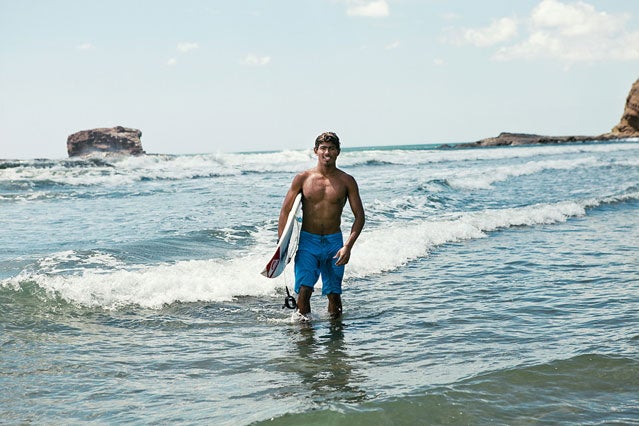
Access and Resources
Customize a trip through Careli Tours; . HOW TO GET THERE: Fly direct to Managua on Continental from Houston or on a number of airlines from Miami. WHEN TO GO: Late November through May for the Pacific coast; avoid the Caribbean side—hurricane season—in October and November. WHERE TO STAY: Strand yourself at Jicaro Island Ecolodge; doubles, $480; . On the Pacific coast, Hotel Punta Teonoste’s thatch-roofed bungalows sit on an empty mile-long beach near stellar surf breaks; $100 per night per person, including breakfast; . Down the coast, Morgan’s Rock Hacienda and Ecolodge is set on 4,448 ac…
The beach at Hotel Punta Teonoste
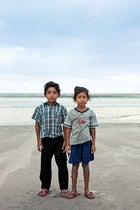 The beach at Hotel Punta Teonoste
The beach at Hotel Punta TeonosteThe Cathedral of Leon
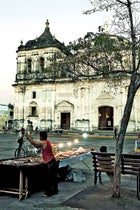 The Cathedral of Leon
The Cathedral of LeonThe author on Cerro Negro
 The author on Cerro Negro
The author on Cerro NegroTHE WIND IS HOWLING, the bats are flying, and I’m on the wrong side of the zona de peligro—no pase sign, peering into what 16th-century Spanish priests considered to be the burning maw of hell. It’s after-hours at Masaya Volcano National Park, Nicaragua’s first, where a 36-square-mile caldera gracefully rises 2,095 feet above the dry tropical forest halfway between the capital, Managua, and the colonial city of Granada. The crater I’m peering into, Santiago, is one of the most active in Central America, spewing as much as 1,200 tons of sulfur dioxide per day. The pulsing thump of glowing magma 1,246 feet below sounds like crashing waves. It’s so mesmerizing that I take a step closer.
If this park were in the U.S., there would be a six-foot chain-link fence topped by razor wire circling the crater rim. But Nicaraguans have a large appetite for risk and a practically nonexistent national-park budget. This no-barriers connection to what lies beneath, as well as nighttime tours of massive bat caves, are what make the park so sensational. My guide, Juan Carlos Mendoza, was here at Masaya in 2001 with 150 American tourists when it erupted.
“I heard a boom and thought it was dynamite,” Mendoza says. That’s when a volcanic rock bombed his bus, making evacuation difficult. Since everyone came out alive, Mendoza, a 50-year-old former Sandinista, remained calm. He’d seen worse.
“Su turno es su turno,” he tells photographer João Canziani and me as, on cue, a deep boom emanates from the crater and I leap toward the “safe” side of the fissure on the rim. In other words, when it’s your time to die, it’s your time to die. Not only do I respect Mendoza’s savant-like knowledge of Nicaragua—from bird species to batty politicians—but after a week traveling together, I’m also starting to get his Latin pícaro sense of humor. It’s dark, spicy, and not at all PC.
It also matches the mood of Masaya, which I’ve deemed the Dark Park because of the near perfect metaphor it creates for Nicaragua’s surreal and violent history. Hundreds of years ago, Masaya was used as a sacrificial altar by the Chorotega Indians, who threw maidens and small children into the crater to appease the goddess of fire. In the 1970s, dictator Anastasio Somoza Debayle’s hit men dumped their tortured prisoners’ bodies here to disappear the evidence. “Beauty, in Nicaragua, often contained the beast,” wrote Salman Rushdie in his 1987 book The Jaguar Smile.
Most Americans know more about its beast than its beauty. Our collective knowledge of Central America’s largest country—slightly bigger than the state of New York, with a population of nearly six million people, and the second-poorest nation in the Western Hemisphere—centers on two events. The first was the five-year civil war that killed an estimated 50,000 Nicaraguans and ended with the socialist Sandinistas’ overthrow of Somoza in 1979.
The second was the contra-Sandinista war, a poorly masked U.S.-Soviet proxy conflict to control this resource-rich banana republic. The war lasted through most of the 1980s and killed 30,000 people, but for Americans the screaming headline was the Iran-contra affair, the 1986 scandal in which the Reagan administration illegally sold arms to Iran in order to fund the contras, the Nicaraguan soldiers trained by the U.S. to overthrow the Sandinistas.
Add a string of corrupt politicians and the 2006 resurgence of President Daniel Ortega, a populist Sandinista whose administration is heavily backed by oil subsidies from Venezuelan president Hugo Chavez, and it’s clear that while Nicaragua is no longer a dictatorship, it isn’t exactly a democracy, either.
But even questionably ethical leadership can’t keep Nicaragua from finally, fully taking advantage of its assets: it may come as a surprise to most Americans that the country is on par with Panama as the second safest in Central America, behind Costa Rica, according to United Nations statistics. It’s also one of the most biologically diverse. More than 18 percent of Nicaragua is protected in 77 parks and reserves, which include the more than five-million-acre Bosawás Biosphere Reserve, the second-largest intact rainforest in the Western Hemisphere. It has 25 volcanoes (seven of which are active); more than 750 bird species; empty, world-class surf beaches on the Pacific; unexplored jungles on the Caribbean; and a population that is pulling itself up by its bootstraps through tourism. With a growing number of colonial hotels and designer eco-lodges, the allure of Nicaragua is no longer a secret. More than a million foreigners—210,479 from the United States—visited in 2010. Like Costa Rica 20 years ago, Nicaragua is on the cusp of going mainstream.
It’s impossible to see the entire country in ten days, so we’ve started in Managua and are making a figure-eight loop northwest to the city of León and the beaches of the Pacific; then to Granada; then turning south to the expat surfing hot spot San Juan del Sur. From there we’ll visit the newly anointed World Biosphere Reserve of Ometepe Island in Lake Nicaragua—the largest freshwater body in Central America—and finish back in Managua.
Tonight we’ve diverted from the gringo trail altogether. The park is deserted, and we have the glow of the Masaya Volcano and the distant view of moonlit Lake Nicaragua to ourselves. From this vantage point, it feels like Nicaragua’s moment is now.
“I CONSIDER MYSELF to be very nationalistic. I love my country,” Mendoza tells me as we speed toward Managua in a white SUV. We’ve been poking around the ruins of León Viejo, the second-oldest Nicaraguan city, founded in 1524 and destroyed by a severe earthquake in 1610. This former gold-trading center is Nicaragua’s first World Heritage site.
“Our history is very heroic,” Mendoza continues. “This country has so much potential, but I don’t think I’m going to live long enough to see its future.”
Mendoza is the future of Nicaragua. Five foot eleven and barrel-chested, he speaks impeccable English, wears a military buzz cut, has a massive jaguar tooth dangling around his neck, and never takes off his name tag. He’s the country’s conduit to the world—from everyday people on up. When Pope John Paul II was scheduled to visit in 1996, Mendoza was the man assigned to show him around. Unfortunately, the plans were changed at the last minute.
“I could have ridden in the Popemobile!” he says dejectedly.
Mendoza was also, as they say, “en la lucha”—in the fight. After graduating from John F. Kennedy High School in Fremont, California (his family sent him to the U.S. after an earthquake demolished Managua), in 1980, he was selected by the ministry of tourism to undergo a yearlong intensive training program, studying the history, geography, wildlife, flora, fauna, and volcanology of Nicaragua. In November 1983, he was hired as one of the country’s first official tour guides. Five months later, he was drafted into the Sandinista army. Mendoza went off to the jungle without complaint.
“I thought it was correct to defend my country,” he says.
After two years, Mendoza was allowed to return to his tourism job; he was assigned VIPs like Kuwaiti princes and a Central American president. He’s been at it ever since, guiding for Careli Tours, a company owned by the Melchiors, the family that pioneered Costa Rican environmental tourism.
It’s impossible to fully understand a country as conflicted and convoluted as Nicaragua. While it helps to study the past, it doesn’t do any good to dwell on it. Within an hour’s radius of León, there are plenty of ways to ditch the beast and connect with the beauty. We hiked 2,395-foot Cerro Negro Volcano, a jet-black dome with a crater so active that it melted Canziani’s hiking boots. On Juan Venado Island, a mangrove-lined estuary that parallels the Pacific, we saw caimans and a pale-billed woodpecker so elusive that Mendoza had to look it up in his Birds of Costa Rica book—Birds of Nicaragua doesn’t yet exist. A few miles up the coast in the village of Las Peñitas, we ate ruco, a whitefish fried whole and sautéed in tomatoes and red sauce, under palapas overlooking a wild beach that stretched for miles.
A day later, we’re 80 miles southeast on a 23,100-square-foot island in the northwest corner of Lake Nicaragua. It’s one of the only freshwater lakes in the world populated by sharks. (The dictator Somoza delighted in feeding them cows.) We’re sharing Jicaro Island Ecolodge with a Colombian photographer, his assistant, and a Brazilian model, who are here to shoot a cover for a tony U.S. travel magazine. This stunning and simple nine-casita lodge, which opened in 2010, was the vision of British businesswoman Karen Emanuel, who partnered with British architect Matthew Falkiner to create an oasis made from local volcanic rock and recycled wood. This is one of those getaways where, after you’ve completed your yoga, meditated, and taken a dip in the lake, the chefs will prepare you a honey-infused tropical-fruit smoothie for breakfast before you sprawl out by the pool.
But sometimes the beast rears its head even in paradise. An employee at Jicaro, who wished to remain nameless, began fighting for the Sandinistas at 17.
“I try to forget it. It wasn’t a good time,” he told us at breakfast. “If I wanted to smoke a cigarette, I had to hide it in a banana leaf so the enemy couldn’t see the light and kill me.”
The only benefit of the war, he adds with a smile, was that when it finally ended there were seven women for every man. “I’m so happy because my wife is young and I enjoy life,” he says. “The war was over 20 years ago. Now all we have is a beautiful future.”
FOR THE GOOD LIFE, wealthy Managuans and expat surfers congregate on the Pacific coast at San Juan del Sur. Twenty-five miles northwest of the Costa Rican border, the beach town of 18,500 people sits on a half-moon bay with a statue of Jesus looking down from one hillside and the guests at the luxury Pelican Eyes resort looking down from the other. We’re in town only long enough to pick up Rex Calderon, the 19-year-old Central American surfing champion, who grew up a block from the beach. The unassuming five-foot-six, mustached and muscled pro is going to show us how to catch a wave Nicaragua style.
From San Juan del Sur, Mendoza drives 30 minutes north on a dirt track through the dry scrub and stops at a wooden gate manned by two armed security guards. One of them pokes his head into our SUV and charges $3 per person to enter the private property that grants access to Playa Hermosa, a beach so untouched that the last two seasons of Survivor were filmed here. A few miles beyond the gate, the road dead-ends at a parking lot where a truckload of local surfers are packing it in for the day. The offshore breezes here are generally perfect in March and April, but it’s February and the heavy winds blowing off Lake Nicaragua, to the east, are chopping up the swell.
Beyond the palm trees and palapas, the beach opens up into a mile-long crescent. To the southwest, the mountains of Costa Rica rise in the hazy distance. Out on the water, Calderon, who has been sponsored by Quicksilver since he was 13 and is Nicaragua’s answer to Mick Fanning, is cutting through the waves with the grace of a cat, launching impressive air and popping effortless 360s. To his right is Johnny Goldenberg, a 43-year-old Canadian expat and local real estate entrepreneur who moved to San Juan del Sur five years ago. With a gap-toothed smile and a body full of tattooed Buddhist wisdom, Goldenberg is Calderon’s benefactor, providing him with Eberly boards.
“Rex is a good kid—he doesn’t drink, smoke, or do drugs,” Goldenberg tells me as he zips up his wetsuit. “And he’s a coldhearted killer in a contest. The only problem is trying to get him to leave Nicaragua to compete. He loves it here.”
“I’ve had to travel far and wide to find a surf spot with only three guys in the water,” he continues. “The only way I’m leaving is if I can’t afford to live here anymore. Nicaragua is a cross between Cuba and Cabo. It’s got that natural beauty, but the look and feel of socialism. The nervousness when nobody would invest is gone.”
A friend of Calderon’s has just finished telling me how safe it is here when a security guard wearing a BEER IS AN APPETIZER T-shirt drives up in a rusty Land Cruiser and urges me to hide my camera. The only other person within a mile is a woman in a bikini sunbathing. I wonder out loud who he thinks might steal it. The security guard points to the dense jungle scrub behind the beach and is about to expound when a surfer appears out of the water. He introduces himself as Juan Manuel Caldera, a local developer.
“It’s very simple. We have kids who watch surfers with fancy sunglasses and shorts, and they start snatching things,” Caldera explains. “We’ve solved that by putting security here.”
Caldera, it turns out, is a Nicaraguan journalist who covered the contra-Sandinista war for NBC and now owns the off-the-grid solar-powered development Las Fincas, a few miles away. He, like Mendoza, had the resources to leave Nicaragua during the worst years. But for both men, the pull toward home was too strong to resist.
“Nicaragua is the safest, most wonderful country in Central America,” Caldera tells me as we slowly walk back down the empty beach. “But it’s all about perception. We have got to change the perception.”��
Fishing in Panama
Redefine roughing it in Islas Secas
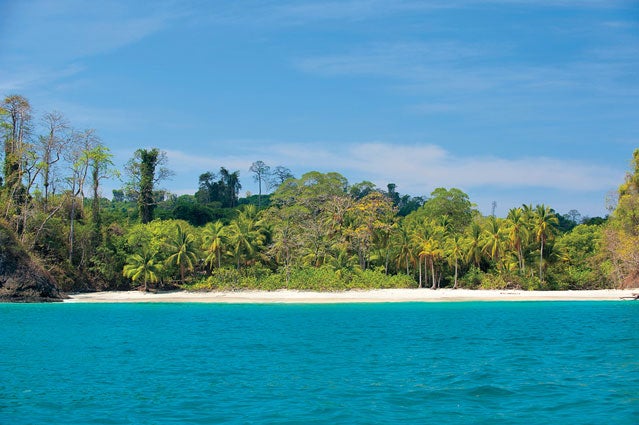
ACCESS AND RESOURCES
From $600 a night, all-inclusive (except fishing); a weeklong fishing package starts at $6,000; . HOW TO GET THERE: United flies to Panama City from Houston; from there, catch a domestic flight to David, and the resort will send a driver and a boat to fetch you. WHEN TO GO: December to May. ALSO CHECK OUT: You can see the Gulf of Chiriquí on a budget, too. Day trips to Coiba leave from the diving hub of Santa Catalina; stay overnight in a modest cabin at the ranger station if you bring your own kit ($20; ).
��
Life in Panama
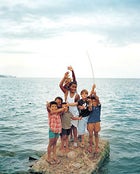 Life in Panama
Life in PanamaFishing near Isla Parida
 Fishing near Isla Parida
Fishing near Isla ParidaA palapa at the Islas Secas Resort
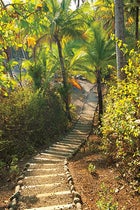 A palapa at the Islas Secas Resort
A palapa at the Islas Secas ResortThe path to dinner
 The path to dinner
The path to dinnerThey left us there, on that deserted island. My husband and I watched as the 40-foot Munson landing craft pulled away, beaching us on a speck of jungle surrounded by the Gulf of Chiriquí. We had only our bathing suits, two beach umbrellas, a double kayak, snorkels, masks, fins, a cooler of Balboa beer, two fresh pasta salads, four fluffy towels, sunscreen, bug stuff, and a shortwave radio. These meager provisions would have to last us three hours.
It was our two-year anniversary. We waved and set off in our kayak to explore Isla Pargo, one of 16 islands in the remote private archipelago of Islas Secas.
I’d heard about Islas Secas Resort from my childhood friend Carter Andrews. Carter and I grew up normally enough in Nashville, Tennessee, but then he went on to become one of the world’s best fishing guides, with sea-monster cameos on ESPN. Last year he signed on as the fishing director for Islas Secas and several other properties owned by a conservation-minded billionaire. “You’ve
got to get down here,” he told me. “This place is ridiculous.”
He wasn’t kidding. The approach alone is like something out of Jurassic Park. From the small mainland fishing-lodge settlement of Boca Chica, we hopped in a 34-foot SeaVee boat and roared an hour toward the Pacific horizon. By the time we sighted Islas Secas, 25 miles out, the mainland had disappeared. We slowed past green cliffs lined with frigate birds and arrived at a long dock where Enrique the bartender waited with two papaya smoothies.
Islas Secas is my kind of roughing it. Guests stay in seven solar-powered yurts, each with its own bathroom and a plantation bed wrapped in mosquito netting. Every morning at 6:30, Enrique delivered a fresh carafe of coffee. Dinner was a stroll to another yurt on a crescent-shaped beach, where chef Alexander Rojas cooked up fish curry and fresh-picked-mango cheesecake on a bay that, each August, fills with breaching humpback whales.
That’s the real draw of Islas Secas: the sea life—parrotfish, puffer fish, king angelfish, shovelnose guitarfish; whitetip reef sharks, green and ridley turtles, spotted and spinner dolphins. The Gulf of Chiriquí serves as a nursery for the Tropical Eastern Pacific Marine Corridor, a nutrient-rich highway of currents stretching from Costa Rica all the way to the Galápagos. To put that a little less scientifically: the fishing and diving are insane. Much of this bounty is found in Coiba National Park, a 430,825-acre sanctuary surrounding the 124,320-acre volcanic island of Coiba. Coiba was belched up from the Galápagos hot spot 70 million years ago. More recently, until 2004, it was Panama’s most notorious penal colony. Now a Unesco World Heritage site, the park includes the most biodiverse waters in the region. Islas Secas is the closest jumping-off point.
We circled Coiba one day with Carter and his family, his three-year-old daughter, Payton, snorkeling alongside her mother in 25 feet of clear water. But most days we fished, banging 30 miles out to the seamount of Montuosa to cast popping lures for 50-pound yellowfin tuna. Carter has a bear’s physique and a bruin’s mane of hair; his first mate, local Juan Spragge, is a 21-year-old fishing prodigy. The other captains call them Yogi and Boo-Boo, which might bother them more if they weren’t tagging and releasing more 700-pound marlin than anyone else on Panama’s Hannibal Bank. At one point, we came upon four boobies sunning themselves on a floating log, watching for fish. Carter stopped the boat. “Mahi—under there,” he said. One cast and a dorado was on the line, flashing green. Carter handed me the rod.
“You know what you caught there?” he said, radioing back to Chef Alex that dinner was in the boat. “Passion-fruit ceviche.”
Surfing in Costa Rica
Get schooled on the Nicoya Peninsula
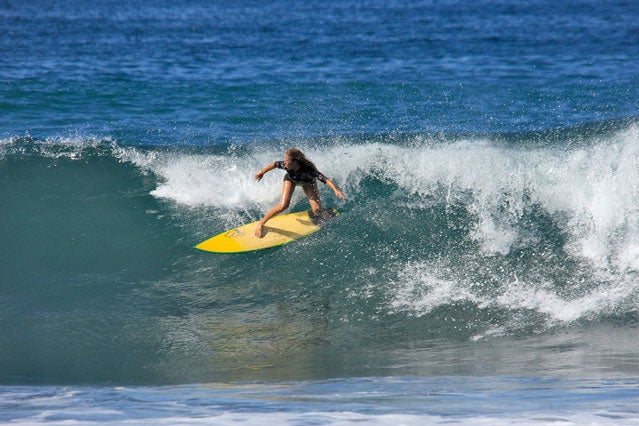
ACCESS AND RESOURCES
From $2,570 a week, all-inclusive; . HOW TO GET THERE: Delta, American, and Continental fly to Liberia; from there, a Surf Simply rep will drive you the two hours to the resort. WHEN TO GO: The dry season, December through April, and the green season, June, July, August, and November; the resort is closed May, September, and October. ALSO CHECK OUT: Spencer Klein, Jack Johnson’s former tour assistant, spent years traveling in Central America. In addition to one-day kayaking, birding, and SUP outings, his adventure outfitter, Experience Nosara, offers weeklong SUP and paddle-surfing tours in the area and guided charter-boat surf trips in Costa Rica, Panama, and Nicaragua;
, . $800 per person for a 3.5-hour expedition to 2,000 feet; Stanley Submarines, . HOW TO GET THERE: Continental and Taca offer nonstop flights to Roatán from several U.S. cities. WHEN TO GO: February and March, for calm water and high visibility. ALSO CHECK OUT: Ask around the West End for the one and only Miss Mazy Ann, who makes the island’s best conch soup and iguana.
WITH MORE THAN 700 species of birds and an expanding national-park system, Honduras is no slouch when it comes to land-based offerings. But the real draw is underwater. If you’ve heard of Roatán, it’s for good reason: deep cuts in the reef around the island drop thousands of feet, offering vertiginous wall diving, wreck exploration, blooming coral, and high visibility. Head to the island’s laid-back West End for white-sand beaches, open-air bars, and the Cocolobo hotel, which has a sweet infinity pool and ten balcony rooms. Nearby you’ll find accredited dive outfitters of long standing like Coconut Tree and West End Divers. If you’ve got the cojones, explore the bizarre deep-sea universe of jelly-nosed eels and ghost sharks with Karl Stanley, a 37-year-old American inventor who takes aspiring Nemos thousands of feet down in his homemade submarine, Idabel.
Guatemala
Learn Spanish—and set up base camp—in Antigua
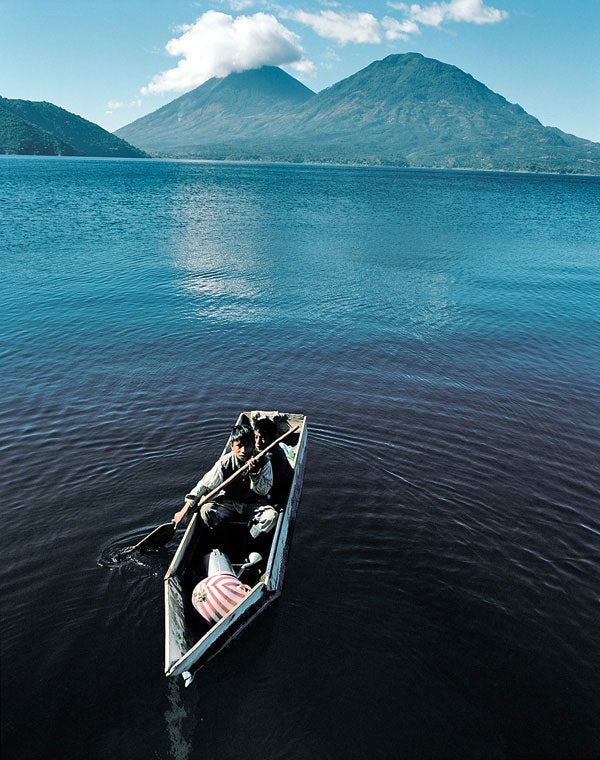
ACCESS AND RESOURCES
Doubles from $190; El Convento, . A week of language instruction, $140; Centro Linguístico Maya, . HOW TO GET THERE: Delta and Spirit fly into Guatemala City, about 45 minutes away. WHEN TO GO: November through August. ALSO CHECK OUT: The Maya ruins at Tikal are the most spectacular in all of Central America. At press time, Guatemala’s government had extended a state-of-siege warning in the region due to an uptick in crime, but Gap �����ԹϺ���s is still running trips to Tikal, and guides say it’s business as usual, albeit with an increased security presence; . Again, go only with a highly recommended guide. SAFETY…
In the Spanish colonial city of Antigua, you’ll find Centro Linguístico Maya, one of the country’s best Spanish language schools. In the shadow of three towering volcanoes, the Centro offers one-on-one instruction up to seven hours a day with a private tutor; then practice what you’ve learned at outings to local markets and ruins. For total immersion, stay with one of the school’s hand-vetted local families or check in to the lush digs at El Convento, across from the partially intact ruins of the 18th-century Capuchin convent. Antigua is a perfect jumping-off point to stunning, more than thousand-foot-deep Lake Atitlán—30 miles away in the western highlands—with sheer-cliff trails and vibrant Maya villages. But don’t go it alone: petty theft and violent crime are on the rise throughout the country. Always travel in a group with an experienced guide.
Belize
Track jaguars and whales from a Caribbean eco-lodge
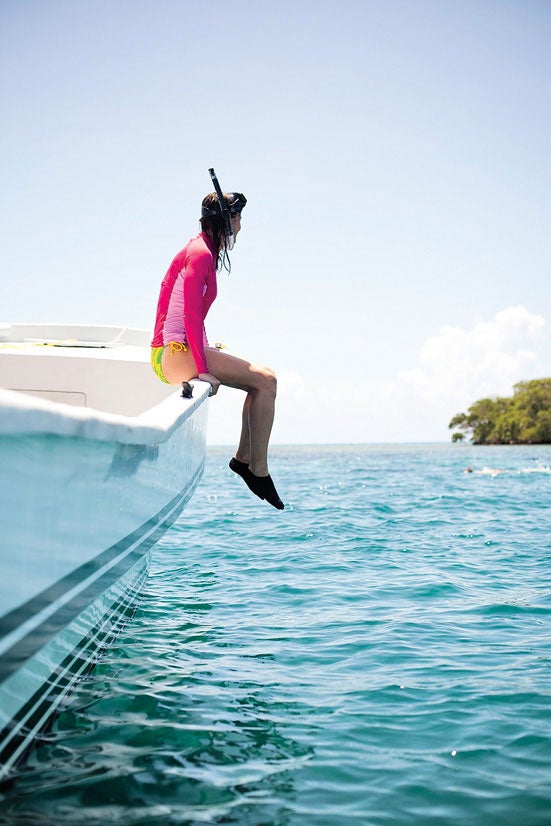
ACCESS AND RESOURCES
��Doubles from $195; Hamanasi Resort, . Doubles from $285; Turtle Inn, . HOW TO GET THERE: American, Delta, and Continental fly direct to Belize City; take a puddle-jumper to Dangriga (for Hamanasi) or Placencia (for Turtle Inn). WHEN TO GO: April to June, between the dry and rainy seasons. ALSO CHECK OUT: From San Ignacio, hike to Actun Tunichil Muknal, a rare archaeological wet cave lined with Maya relics and the tomb of a young maiden. Go with Pacz Tours, whose guides are certified in caving and wilderness rescue; .
SANDWICHED between Mexico and Guatemala, English-speaking Belize boasts more than two million acres of forest, 180 miles of pristine Caribbean coastline, and dozens of innovative eco-lodges. Two of the best? The Hamanasi Resort has treehouse bungalows on a 12-mile stretch of beach minutes from 100-foot waterfalls. The soundtrack is chachalaca birds calling raucously, and daily activities include tracking jaguar prints in the Cockscomb Basin Wildlife Sanctuary, ringed by the Maya Mountains. For diving, head to Francis Ford Coppola’s posh Turtle Inn, where the Mesoamerican Barrier Reef—the largest in the Western Hemisphere—is just offshore. From April to June, you’ll dive with migrating whale sharks, which come to feed on coral spawn during the full moon.
Surfing El Salvador
Explore the Libertad coast's Pacific breaks

ACCESS AND RESOURCES
Weeklong trips from $2,640 for two (lodging included); . HOW TO GET THERE: American and Taca offer nonstop flights to San Salvador from major U.S. hubs. WHEN TO GO: November to May. ALSO CHECK OUT: Wakesurfing in the mangrove-lined tributaries of Estero de Jaltepeque. Ask Cadejo’s owner, Roy Beers, to take you. SAFETY UPDATES: Read the State Department’s current travel advice at .
Uncrowded breaks
 Uncrowded breaks
Uncrowded breaksTHE CIVIL WAR is long past, but ongoing gang violence—though it rarely affects travelers—means robberies can happen. Which is why you’ll see armed guards at the supermarket and why we recommend going with a guide. But don’t wimp out, because this tiny country is packed with empty surf, 7,000-foot active volcanoes, and killer pupusas—fresh corn tortillas filled with refried beans and cheese. Plan a multisport trip with the locals at Cadejo �����ԹϺ���s. Start 30 minutes south of San Salvador on the La Libertad coast, where uncrowded Pacific breaks range from mellow El Sunzal to perilous Punta Roca, a legendarily long and bone-crushing right. Luxury can be had for less at Casa de Mar, a series of hillside cottages overlooking El Sunzal. After a few days of guided wave hunting, head inland to El Imposible National Park for two days of hiking and canyoneering through epic gorges, with rare emerald toucans and aardvarks for company.




